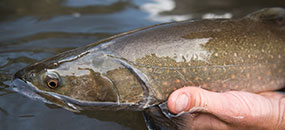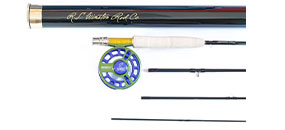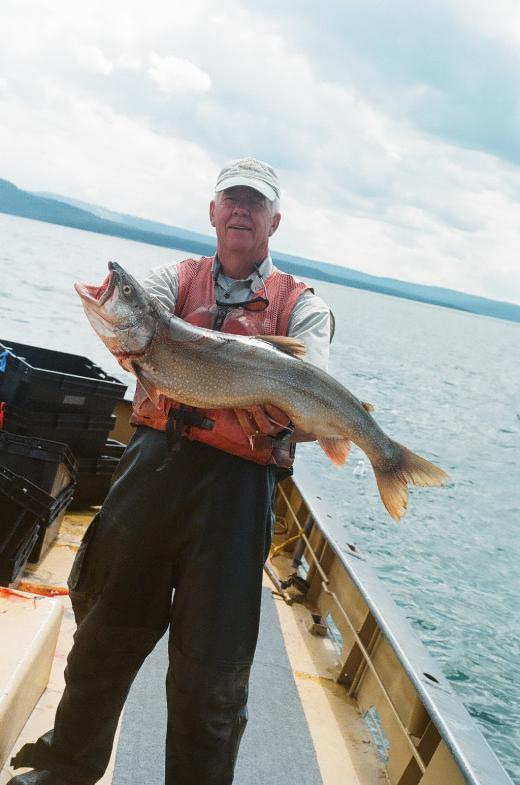TU’s Dave Sweet was recently selected as a Field and Stream Hero of Conservation and featured in the February issue of the magazine. Dave’s TU accomplishments read like a laundry list as long as a two-handed fly rod. Most recently, he has been integral to the efforts to save the Yellowstone cutthroat trout in Yellowstone Lake and the tributary systems surrounding the lake. Scott Christy, Wyoming Coordinator for Trout Unlimited, recently caught up with Dave in his home in Cody.
Q. Dave, we’re pretty impressed that you’ve been selected as a Field and Stream Hero of Conservation and were featured in the February issue. That’s a great honor. How did that come about?
A. Thank you. It is a great honor and I am humbled by it. The award was initiated by the Conservation Chair of the East Yellowstone Chapter here in Cody, Bob Capron, who is himself a "Hero of Conservation" from two years ago for his work is rescuing trout from irrigation diversions . Bob has been following our work on the Yellowstone Lake system and felt that it was deserving. He made the initial call through his contacts and made the nomination.
Q. That’s fantastic. How did you first get involved with this issue on Yellowstone Lake?
A. I started fishing the Yellowstone Lake system about 40 years ago and fell in love with it, then 25 years ago I was fortunate to be able to move close to the Park and could fish it regularly. When the lake trout was first found in the Lake, I was devastated; but like most, I didn't think it would have the impact that it since has. In 2007 I became aware of the drastic decline in the Yellowstone cutthroat population by a presentation that we had at our Cody chapter meeting. I was struck by the gravity of the situation and pledged that night that I would do whatever I could to help.
Q. Why is the lake so important for Yellowstone cutthroat trout?
A. The Yellowstone cutthroat is in trouble throughout its range. Habitat degradation, drought, competition and interbreeding with introduced non-natives, and general non-concern for native trout species has resulted in over half the historic range currently being devoid of these fish. Elsewhere, they are hybridized significantly. At one point, the fish was petitioned for listing under the ESA. Yellowstone Lake and the surrounding Yellowstone River system was thought to be the stronghold where none of the negative influences could harm this major population. In less than our adult lifetime we have seen the population drop from around 4 million to less than 10% of that number. The whole Yellowstone ecosystem has suffered as a result. Major predators like grizzly and black bears, raptors like eagles and ospreys, river otters and dozens of other species used to depend on these cutthroats for a major portion of their diets. Today, the lake trout don't replace the natives in this ecosystem. Their life habitats make them unavailable to these other animals. So, anglers and conservationists of all kinds are deeply troubled by this loss.
Q. We’ve read a lot about the recent movement study that TU is helping fund to better understand lake trout behavior and locate spawning grounds. What will that data be used for and what else can be done?
Unfortunately, there is no silver bullet to rid Yellowstone Lake of lake trout. The National Park Service has been using an exhaustive netting program to drive the adult lake trout population down. However, it will probably never be eliminated. And, the cost of netting is huge, around $1.5 million annually. That kind of expenditure can't be sustained forever.
Q. What is this stealth tactic we've been hearing about?
A. Well, there is an alternative to suppress the lake trout recruitment. We have to kill the eggs or keep the lakers from spawning. But in order to do that, you have to know exactly where and when the lake trout spawn. This is where Trout Unlimited has had its biggest influence. We have been raising (with our partners the Greater Yellowstone Coalition and the National Parks Conservation Association) money to pay for a deep water telemetry study called a hydro-acoustic telemetry study. So far we've raised about $175,000. This study conducted by the NPS and the USGS implants radio tags in lake trout and monitors their movements around the system. Their movement patterns can be used to more efficiently net the adults while the location of their spawning beds can be used to kill the spawning fish, their eggs and the fry. The scientists are right now in the middle of a three year telemetry study.
Q. Can it really be done? Can we really see success on this issue?
A. It can. We're already seeing some successes. The population of lake trout is declining due to the netting efforts and the population of Yellowstone cutthroats is recovering, slightly but significantly. We have a long way to go but the tide has turned. People have hope and we have the tools to make it happen.
Q. What can people do to help?
A. I mentioned earlier that we are in the middle of a three year telemetry study, and then the egg suppression techniques have to be scaled up. All of this work will take money and time. The agencies have pledged the time; we have to keep the money flowing. Right now we are anticipating hardware costs for this summer alone to be $118,000. Currently we are $75,000 short. We need interested chapters, councils and individuals to continue to dig deep and make it happen. Both the Wyoming Council and the East Yellowstone Chapter are collecting money for the project.
Q. Thanks for keeping track of this issue. Will we be seeing more of you in Field and Stream in the months to come?
That's an unknown. Field and Stream has three awards per month and then recognizes 5 individuals at the next level, finally selecting the yearly "Hero of Conservation". I am hopeful that Field and Stream will recognize the importance of this project.






Comments
Dave Sweet - the real deal, and a true conservation hero. You deserved this one, Dave!